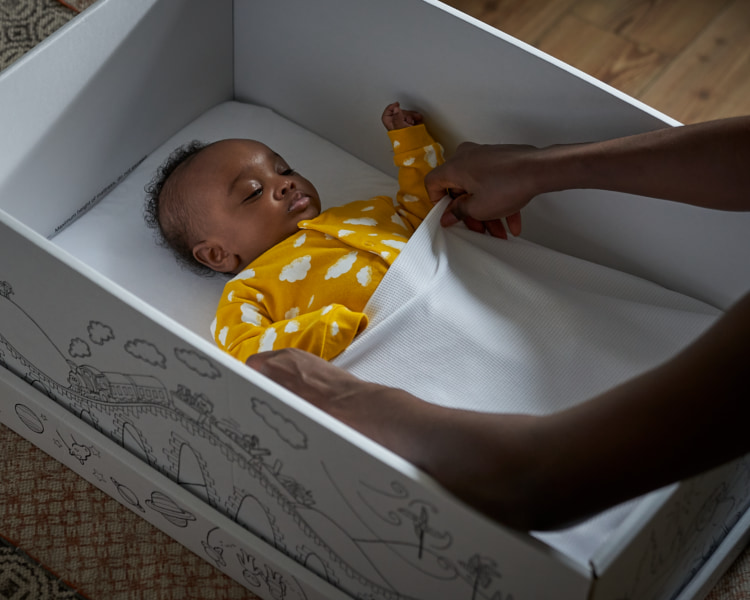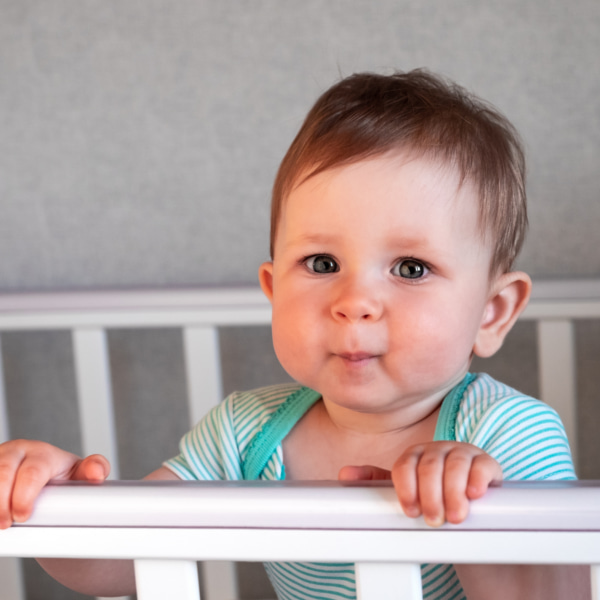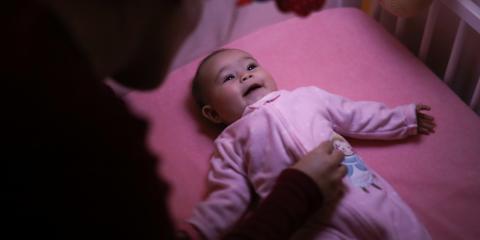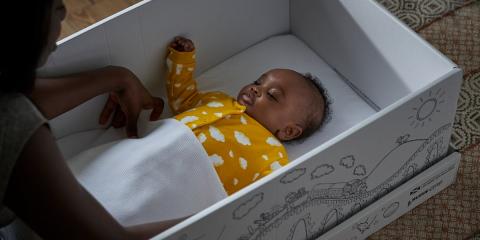Newborn babies tend to sleep a lot – they just don’t sleep for very long at any one time! So you probably won’t get much sleep yourself, especially to begin with. But there’s nothing nicer than seeing your wee one happily snoozing – especially if you can grab a quick nap too. It’s always good to know how to keep your baby as safe as possible while they’re asleep, so here are some great tips for sweet dreams.
Using the Baby Box for safer sleep
This video shows you how you can keep your baby safe when they're in the Baby Box.
Top tips for safer sleep
Tip #1: Safest sleeping position

Always put your baby to sleep on their back in a clear, flat sleep space (for most babies this will mean a cot or Moses basket) with their feet at the bottom of their cot and any blankets tucked under their arms and under the mattress. This is the safest position for sleeping.
Tip #2: Check your baby's temperature
Check your baby is a comfortable temperature by touching their tummy, or the back of their neck. Your baby’s face and head should stay uncovered when they’re asleep. Try to keep the room temperature between 16 and 20 degrees so your baby doesn't get too hot or cold and make sure their bedding is appropriate for the time of year.
Tip #3: No smoking
Never allow anyone to smoke anywhere near your baby – and never put your baby in a room or car where people have smoked, as this increases the risk of Sudden Infant Death Syndrome (SIDS) (cot death). You can find out more about SIDS on our common questions about safer sleeping page.
Tip #4: Keep the space clear
Ensure that the sleep space is kept clear of all items such as pillows, duvets or cot bumpers and there is nothing within reach of the space, such as blind cords, soft toys or nappy sacks.
Tip #5: Keep them close
Your baby should stay in the same room as you for daytime sleeps as well as at night (great that the Baby Box is so portable!)
Tip #6: Be careful
Never fall asleep with your baby on a sofa or a chair.
What the professionals say
"We introduce safer sleep right from early pregnancy so that mums and dads get an idea of some of the equipment they need to think about, the equipment they need to buy to avoid things like cot bumpers, avoiding putting things into cots, just having the cots with blankets only, having cellular blankets rather than cot quilts or anything like that, to avoid pillows, and we try so that they’re starting to think about all that even during pregnancy.”
More help and advice
Our page on safer sleep has further information. You can also download the Scottish Government and NHS Safer Sleep resources on safer sleep in English, Arabic, Bengali, Cantonese, Gaelic, Mandarin, Polish, Punjabi, Romanian, Russian, Slovakian, Ukranian and Urdu. You can also download a quick reference card here.
For more help and advice on how to make sure your baby is sleeping as safely as possible, visit:
You can also speak to your midwife or health visitor.
 Activities & Play
Activities & Play Behaviour
Behaviour Childcare
Childcare Development & Growing Up
Development & Growing Up Family, Friends & Relationships
Family, Friends & Relationships Feeding Your Baby
Feeding Your Baby Food & Eating
Food & Eating Health & Safety
Health & Safety Mental Health & Wellbeing
Mental Health & Wellbeing Money & Work
Money & Work Online Behaviour & Safety
Online Behaviour & Safety Pregnancy & First Days
Pregnancy & First Days School & Education
School & Education Sleep
Sleep









 Mental Health & Wellbeing
Mental Health & Wellbeing
 Health & Safety
Health & Safety